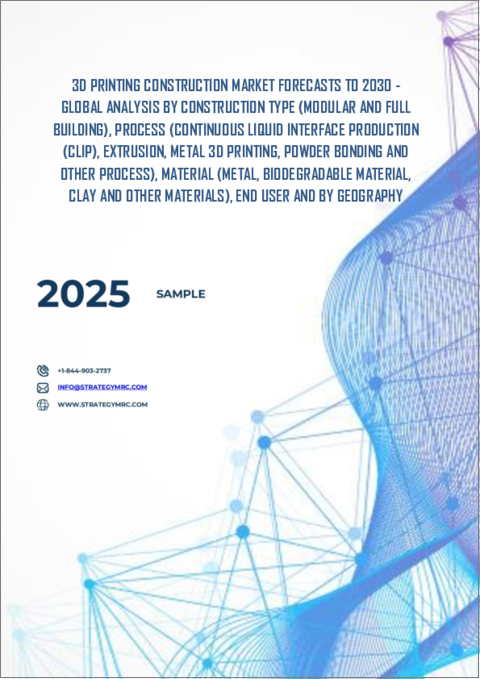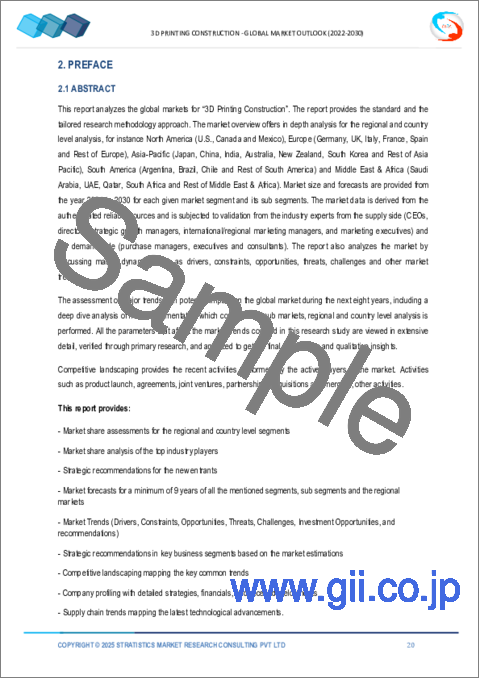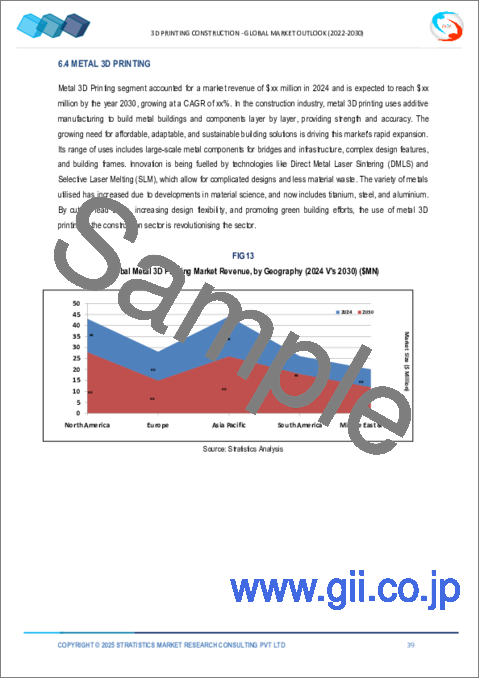|
|
市場調査レポート
商品コード
1371874
3Dプリンティング建設市場の2030年までの予測: 建設タイプ、プロセス、材料、エンドユーザー、地域別の世界分析3D Printing Construction Market Forecasts to 2030 - Global Analysis By Construction Type, Process (Continuous Liquid Interface Production, Extrusion, Metal 3D Printing, Powder Bonding and Other Process), Material, End User and By Geography |
||||||
カスタマイズ可能
|
|||||||
| 3Dプリンティング建設市場の2030年までの予測: 建設タイプ、プロセス、材料、エンドユーザー、地域別の世界分析 |
|
出版日: 2023年10月01日
発行: Stratistics Market Research Consulting
ページ情報: 英文 200+ Pages
納期: 2~3営業日
|
- 全表示
- 概要
- 図表
- 目次
Stratistics MRCによると、世界の3Dプリンティング建設市場は2023年に48億米ドルを占め、予測期間中のCAGRは85.3%で成長し、2030年には3,605億8,000万米ドルに達すると予測されています。
3Dプリンティング技術を使った建設では、3Dプリンターで3D構造をレイヤーごとに印刷します。この技術を実証するために、研究者はポリマー、コンクリート、金属でできた橋をオフサイトで印刷したり、粘土やコンクリートでできた完成した建物をオンサイトで印刷したりしています。この方法では、使用する材料が少なく、労働力も少なくて済むため、建設がより迅速に完了します。
2021年世界グリーンビルディング動向調査によると、調査対象企業の約42%が、2024年までにプロジェクトの約60%をグリーン技術で建設すると計画しています。
建設業界の急成長
デジタル画像を物理的なモデルに変える能力を持つ3Dプリンティングは、建設分野では極めて重要です。コンクリート、金属、ポリマーなどの素材を利用し、専用の3Dプリンターでリアルタイムの3Dモデルを作成できます。3Dプリンティングの使用は、デザイナーや建築家が、時間とコストがかかり、集中的な労働を避けながら、あらゆる複雑なデザインを構築するのに役立ちます。その結果、予測期間中、この需要の高まりが市場の成長を促進すると予想されます。
高い資本支出
建設現場での3Dプリンティング技術の普及を阻む主な要因は、こうした機器の購入コストが高いことと、大型の3Dプリンターを現場に運ぶ際の物流上の課題であると考えられます。3Dプリンターは高額で、初期購入価格には消耗品や維持費が含まれていないため、普及の妨げになっています。
ビルディング・インフォメーション・モデリング(BIM)の採用
業界の成長(BIM)に影響を与える主な要因の1つは、建築情報モデリング(BIM)の利用が着実に増加していることです。BIMは、エンジニアリング、アーキテクチャ、インフラストラクチャ分野のデジタル変革の要です。不動産開発業者、建築家、エンジニア、製造業者、請負業者、その他のインフラ専門家が、この共同チーム・ソリューションを使って、3D構造物や建物を計画、設計、建設することができます。この市場は、製造コストと材料廃棄量の削減により拡大しています。さらに、環境に優しいリサイクル素材を三次元プリンターに使用することもできます。こうした要因がコスト削減につながり、今後の成長を後押しします。
設計上の制約と熟練工の不足。
3Dプリンターを従来の工法と比較すると、建築設計の柔軟性という点で制約が生じる可能性があります。建築家やエンジニアは、3Dプリンティングに対応するために設計プロセスを変更する必要があるかもしれないです。さらに、建設業界における3Dプリンティングの採用には、機器の使用とメンテナンスができる熟練労働力が必要です。建設労働者を再教育することは非常に困難であり、そのため市場がさらに制限される可能性があります。
COVID-19の影響:
世界市場の拡大は、COVID-19の大流行によってマイナスの影響を受けた。パンデミックの発生により、多くの建設プロジェクトに必要な原材料の供給が途絶え、世界中で建設プロジェクトが停滞しました。市場参入企業の大手は減収となっています。しかし、コンクリートから住宅やその他の構造物を革新的に印刷することが現在の動向であり、建設業界はこの技術を採用する利点に注目しているため、3D印刷技術市場に潜在的な成長機会が生まれています。
予測期間中、コンクリート分野が最大になる見込み
予測期間中、コンクリート分野が最大になると予測されています。3Dプリンティングを利用してコンクリートを作成する建築家や建設会社が増えています。コンクリートの3Dプリンティングは、従来の製造よりも効果的で、迅速で、安価で、安全です。コンクリート3Dプリンターを使えば、建設中に高いレベルの弾力性と幾何学的複雑性を実現できます。このような利点から、建設業者は3Dプリンターによるコンクリート型枠の製作に注力しており、これがセグメントの成長を促進しています。
予測期間中、インフラストラクチャ分野のCAGRが最も高くなる見込み
予測期間中、CAGRが最も高くなると予測されるのはインフラ分野です。このセグメントの成長の原動力となっているのは、金属、プラスチック、複合材料などの材料を使用して、家具や橋などのインフラストラクチャを構築するために3Dプリント技術の利用が拡大していることです。さらに、世界中の重要な企業が3Dプリント橋梁を建設するために開始した数多くのイニシアチブも成長を後押ししており、これがセグメント拡大の原動力となっています。
最大のシェアを占める地域
アジア太平洋地域が現在市場を独占しており、予測期間中もその傾向が続くと予想されます。アジア太平洋地域の建設セクターにおける有利な機会は、大きな市場シェアと地域成長のおかげです。中国や日本のような人気の高い国々は、建設における3Dプリンティングを含む最先端技術や確立された技術に数多くの機会をもたらす可能性を秘めています。
CAGRが最も高い地域:
3Dプリント建設市場は、推定期間中にアジア太平洋地域で急成長すると予想されています。同地域の3Dプリント建設の最大市場は、建築とインフラストラクチャー分野です。この地域は、多くのメーカーが存在するため、3Dプリント建設にとって最も重要な市場です。アジア太平洋の3Dプリント建設市場は、主に中国とタイに集中していると見られています。さらに、建築とインフラストラクチャの最終用途分野で3Dプリント建設の需要が大きいことも成長の要因となっています。
無料のカスタマイズ提供:
本レポートをご購読のお客様には、以下の無料カスタマイズオプションのいずれかをご利用いただけます:
- 企業プロファイル
- 追加市場プレイヤーの包括的プロファイリング(3社まで)
- 主要企業のSWOT分析(3社まで)
- 地域セグメンテーション
- 顧客の関心に応じた主要国の市場推計・予測・CAGR(注:フィージビリティチェックによる)
- 競合ベンチマーキング
- 製品ポートフォリオ、地理的プレゼンス、戦略的提携に基づく主要企業のベンチマーキング
目次
第1章 エグゼクティブサマリー
第2章 序文
- 概要
- ステークホルダー
- 調査範囲
- 調査手法
- データマイニング
- データ分析
- データ検証
- 調査アプローチ
- 調査ソース
- 1次調査ソース
- 2次調査ソース
- 前提条件
第3章 市場動向分析
- 促進要因
- 抑制要因
- 機会
- 脅威
- エンドユーザー分析
- 新興市場
- 新型コロナウイルス感染症(COVID-19)の影響
第4章 ポーターのファイブフォース分析
- 供給企業の交渉力
- 買い手の交渉力
- 代替品の脅威
- 新規参入業者の脅威
- 競争企業間の敵対関係
第5章 世界の3Dプリンティング建設市場:建設タイプ別
- モジュラー
- 建物全体
第6章 世界の3Dプリンティング建設市場:プロセス別
- 連続液体界面製造(CLIP)
- 押し出し
- 金属3Dプリント
- パウダーボンディング
- その他の工程
第7章 世界の3Dプリンティング建設市場:材料別
- 金属
- 生分解性材料
- 粘土
- 複合
- コンクリート
- 泥と天然素材
- ポリマー複合材料
- 再利用素材
- その他の素材
第8章 世界の3Dプリンティング建設市場:エンドユーザー別
- 航空宇宙と防衛
- 教育および制度
- エネルギーとパワー
- ヘルスケア
- インフラストラクチャー
- 建物
- 住宅
- コマーシャル
- 産業用
- その他のエンドユーザー
第9章 世界の3Dプリンティング建設市場:地域別
- 北米
- 米国
- カナダ
- メキシコ
- 欧州
- ドイツ
- 英国
- イタリア
- フランス
- スペイン
- その他欧州
- アジア太平洋地域
- 日本
- 中国
- インド
- オーストラリア
- ニュージーランド
- 韓国
- その他アジア太平洋地域
- 南米
- アルゼンチン
- ブラジル
- チリ
- その他南米
- 中東とアフリカ
- サウジアラビア
- アラブ首長国連邦
- カタール
- 南アフリカ
- その他中東とアフリカ
第10章 主な発展
- 契約、パートナーシップ、コラボレーション、合弁事業
- 買収と合併
- 新製品の発売
- 事業拡大
- その他の主要戦略
第11章 企業プロファイル
- Apis Cor
- Beijing Huashang Luhai Technology
- Betabram
- COBOD International A/S
- Contour Crafting Corporation
- CyBe Construction
- ICON Technology, Inc
- Imprimerie AG
- Monolite UK
- MX3D
- Rohaco
- SIKA AG
- Spetsavia
- Total Kustom
- WASP S.r.l
- XtreeE
- Yingchuang Building Technique(Shanghai)Co.Ltd.(WinSun)
List of Tables
- Table 1 Global 3D Printing Construction Market Outlook, By Region (2021-2030) ($MN)
- Table 2 Global 3D Printing Construction Market Outlook, By Construction Type (2021-2030) ($MN)
- Table 3 Global 3D Printing Construction Market Outlook, By Modular (2021-2030) ($MN)
- Table 4 Global 3D Printing Construction Market Outlook, By Full Building (2021-2030) ($MN)
- Table 5 Global 3D Printing Construction Market Outlook, By Process (2021-2030) ($MN)
- Table 6 Global 3D Printing Construction Market Outlook, By Continuous Liquid Interface Production (CLIP) (2021-2030) ($MN)
- Table 7 Global 3D Printing Construction Market Outlook, By Extrusion (2021-2030) ($MN)
- Table 8 Global 3D Printing Construction Market Outlook, By Metal 3D Printing (2021-2030) ($MN)
- Table 9 Global 3D Printing Construction Market Outlook, By Powder Bonding (2021-2030) ($MN)
- Table 10 Global 3D Printing Construction Market Outlook, By Other Process (2021-2030) ($MN)
- Table 11 Global 3D Printing Construction Market Outlook, By Material (2021-2030) ($MN)
- Table 12 Global 3D Printing Construction Market Outlook, By Metal (2021-2030) ($MN)
- Table 13 Global 3D Printing Construction Market Outlook, By Biodegradable Materials (2021-2030) ($MN)
- Table 14 Global 3D Printing Construction Market Outlook, By Clay (2021-2030) ($MN)
- Table 15 Global 3D Printing Construction Market Outlook, By Composite (2021-2030) ($MN)
- Table 16 Global 3D Printing Construction Market Outlook, By Concrete (2021-2030) ($MN)
- Table 17 Global 3D Printing Construction Market Outlook, By Mud and Natural Materials (2021-2030) ($MN)
- Table 18 Global 3D Printing Construction Market Outlook, By Polymer Composites (2021-2030) ($MN)
- Table 19 Global 3D Printing Construction Market Outlook, By Recycled Materials (2021-2030) ($MN)
- Table 20 Global 3D Printing Construction Market Outlook, By Other Materials (2021-2030) ($MN)
- Table 21 Global 3D Printing Construction Market Outlook, By End User (2021-2030) ($MN)
- Table 22 Global 3D Printing Construction Market Outlook, By Aerospace and Defense (2021-2030) ($MN)
- Table 23 Global 3D Printing Construction Market Outlook, By Educational and Institutional (2021-2030) ($MN)
- Table 24 Global 3D Printing Construction Market Outlook, By Energy and Power (2021-2030) ($MN)
- Table 25 Global 3D Printing Construction Market Outlook, By Healthcare (2021-2030) ($MN)
- Table 26 Global 3D Printing Construction Market Outlook, By Infrastructure (2021-2030) ($MN)
- Table 27 Global 3D Printing Construction Market Outlook, By Building (2021-2030) ($MN)
- Table 28 Global 3D Printing Construction Market Outlook, By Residential (2021-2030) ($MN)
- Table 29 Global 3D Printing Construction Market Outlook, By Commercial (2021-2030) ($MN)
- Table 30 Global 3D Printing Construction Market Outlook, By Industrial (2021-2030) ($MN)
- Table 31 Global 3D Printing Construction Market Outlook, By Other End Users (2021-2030) ($MN)
Note: Tables for North America, Europe, APAC, South America, and Middle East & Africa Regions are also represented in the same manner as above.
According to Stratistics MRC, the Global 3D Printing Construction Market is accounted for $4.80 billion in 2023 and is expected to reach $360.58 billion by 2030 growing at a CAGR of 85.3% during the forecast period. Construction using 3D printing technology involves layer-by-layer printing of 3D structures on a 3D printer. To demonstrate the technique, researchers have printed bridges made of polymer, concrete, and metal off-site, as well as finished buildings made of clay or concrete on-site. The method uses fewer materials and requires less labor, so construction can be completed more quickly.
According to the World Green Building Trends Survey 2021, around 42% of the surveyed businesses planned that they would build about 60% of their projects using green technology by 2024.
Market Dynamics:
Driver:
Rapid growth of construction industry
Due to its ability to turn a digital image into a physical model, 3D printing is crucial in the construction sector. Utilizing materials like concrete, metal, polymer, and other materials, specialized 3D printers can create a real-time 3D model. The use of 3D printing helps designers and architects build any complex design while avoiding labor that is time-consuming, expensive, and intensive. As a result, it is anticipated that, over the course of the forecast period, this higher demand will propel market growth.
Restraint:
High capital expenditures
The main obstacles to the widespread adoption of 3D printing technology on construction sites are likely to be the high cost of purchasing such equipment and the logistical challenges associated with transporting these large 3D printers to the job site. A 3D printer costs a lot of money, and the initial purchase price does not include supplies or upkeep, which hinders its growth.
Opportunity:
Adoption of building information modeling (BIM)
One of the main factors influencing industry growth (BIM) is the steadily rising use of building information modeling (BIM). BIM is the cornerstone of the engineering, architecture, and infrastructure sectors' digital transformation. A 3D structure or building can be planned, designed, and built using this collaborative team solution for real estate developers, architects, engineers, manufacturers, contractors, and other infrastructure professionals. The market is expanding as a result of lower production costs and material waste. Additionally, environmentally friendly recycled materials can be used in three-dimensional printers. These factors help to reduce the cost, which drives future growth.
Threat:
Design limitations and a shortage of skilled workers.
Comparing 3D printing to conventional construction methods can result in limitations in terms of flexibility in architectural design. Architects and engineers may need to modify their design processes to accommodate 3D printing. Moreover, the adoption of 3D printing in the construction industry calls for a skilled labor force that can use and maintain the equipment. It can be extremely difficult to retrain construction workers, which further restricts the market.
COVID-19 Impact:
The global market's expansion was negatively impacted by the COVID-19 pandemic outbreak. The pandemic outbreak has disrupted the supply of the raw materials needed for many construction projects, causing them to stall all over the world. The major market participants saw their revenues fall. However, the innovative printing of homes and other structures out of concrete is the current trend, and the construction industry is focusing on the advantages of adopting the technology, which has created potential growth opportunities in the 3D printing technology market.
The concrete segment is expected to be the largest during the forecast period
The concrete segment is anticipated to be the largest during the forecast period. A growing number of architects and construction firms are using 3D printing to create concrete. Concrete 3-D printing is more effective, quicker, less expensive, and safer than traditional manufacturing. A higher level of resilience and geometric complexity can be achieved during construction with the help of a concrete 3D printer. Because of these advantages, builders are concentrating on creating 3D-printed concrete formwork, which is fueling segment growth.
The infrastructure segment is expected to have the highest CAGR during the forecast period
Over the forecast period, the infrastructure segment is anticipated to have the highest CAGR. The growth of this segment is being driven by the expanding use of 3D printing technology to build infrastructure, such as furniture and bridges, using materials like metals, plastic, and composites. Additionally, the growth is also fueled by numerous initiatives launched by important companies around the globe to construct 3D-printed bridges, which is driving segment expansion.
Region with largest share:
The Asia Pacific region currently dominates the market and is anticipated to do so throughout the forecast period. The lucrative opportunities in the construction sector in the Asia Pacific region can be credited to the significant market share and regional growth. Popular nations like China and Japan have the potential to present numerous opportunities for cutting-edge and established technologies, including 3D printing in construction.
Region with highest CAGR:
The 3D printing construction market is anticipated to grow rapidly in Asia Pacific over the estimated period. The region's largest markets for 3D printing construction are the building and infrastructure sectors. The region is the most significant market for 3D printing construction due to the presence of many manufacturers. The Asia-Pacific 3D printing construction market has been viewed as being largely centered in China and Thailand. Additionally, the growth is attributed to the significant demand for 3D printing construction in the building and infrastructure end-use sectors.
Key players in the market:
Some of the key players in 3D Printing Construction market include: Apis Cor, Beijing Huashang Luhai Technology, Betabram, COBOD International A/S, Contour Crafting Corporation, CyBe Construction, ICON Technology, Inc, Imprimerie AG, Monolite UK, MX3D, Rohaco, SIKA AG, Spetsavia, Total Kustom, WASP S.r.l, XtreeE and Yingchuang Building Technique(Shanghai)Co.Ltd. (WinSun).
Key Developments:
In June 2023, RCAM Technologies, an industry-leading provider of three-dimensional (3D) concrete-printed solutions dedicated to offshore renewable energy, has signed a deal to purchase a state-of-the-art gantry robot system, the CyBe GR, from CyBe Construction, a front-runner in the field of 3D concrete printing technologies. By harnessing the groundbreaking capabilities of the CyBe GR, RCAM is set to accelerate the adoption of renewable energy by slashing costs and drastically reducing environmental impacts associated with manufacturing its infrastructure.
In August 2023, L&T Construction, the Indian construction giant with group sales of $23 bill. and a leader in the 3D construction printing industry in India, unveils the country's first 3D printed post office, a groundbreaking project completed in just 43 days. Powered by COBOD's BOD2 3D construction printer, this achievement underscores the immense potential of 3D printing technology in revolutionizing the construction landscape.
In June 2023, Florida-based Printed Farms achieves a groundbreaking feat by completing the printing of the world's largest 3D printed building, a luxury horse barn, using COBOD's BOD2 construction 3D printer, marking another record for the world's most used 3D printer. This unique structure has a total floor area of +10,100 SF / ~940 m2, almost 50% larger than the previous record-holder in the Middle East.
Construction Types Covered:
- Modular
- Full Building
Process Covered:
- Continuous Liquid Interface Production (CLIP)
- Extrusion
- Metal 3D Printing
- Powder Bonding
- Other Process
Materials Covered:
- Metal
- Biodegradable Materials
- Clay
- Composite
- Concrete
- Mud and Natural Materials
- Polymer Composites
- Recycled Materials
- Other Materials
End Users Covered:
- Aerospace and Defense
- Educational and Institutional
- Energy and Power
- Healthcare
- Infrastructure
- Building
- Other End Users
Regions Covered:
- North America
- US
- Canada
- Mexico
- Europe
- Germany
- UK
- Italy
- France
- Spain
- Rest of Europe
- Asia Pacific
- Japan
- China
- India
- Australia
- New Zealand
- South Korea
- Rest of Asia Pacific
- South America
- Argentina
- Brazil
- Chile
- Rest of South America
- Middle East & Africa
- Saudi Arabia
- UAE
- Qatar
- South Africa
- Rest of Middle East & Africa
What our report offers:
- Market share assessments for the regional and country-level segments
- Strategic recommendations for the new entrants
- Covers Market data for the years 2021, 2022, 2023, 2026, and 2030
- Market Trends (Drivers, Constraints, Opportunities, Threats, Challenges, Investment Opportunities, and recommendations)
- Strategic recommendations in key business segments based on the market estimations
- Competitive landscaping mapping the key common trends
- Company profiling with detailed strategies, financials, and recent developments
- Supply chain trends mapping the latest technological advancements
Free Customization Offerings:
All the customers of this report will be entitled to receive one of the following free customization options:
- Company Profiling
- Comprehensive profiling of additional market players (up to 3)
- SWOT Analysis of key players (up to 3)
- Regional Segmentation
- Market estimations, Forecasts and CAGR of any prominent country as per the client's interest (Note: Depends on feasibility check)
- Competitive Benchmarking
- Benchmarking of key players based on product portfolio, geographical presence, and strategic alliances
Table of Contents
1 Executive Summary
2 Preface
- 2.1 Abstract
- 2.2 Stake Holders
- 2.3 Research Scope
- 2.4 Research Methodology
- 2.4.1 Data Mining
- 2.4.2 Data Analysis
- 2.4.3 Data Validation
- 2.4.4 Research Approach
- 2.5 Research Sources
- 2.5.1 Primary Research Sources
- 2.5.2 Secondary Research Sources
- 2.5.3 Assumptions
3 Market Trend Analysis
- 3.1 Introduction
- 3.2 Drivers
- 3.3 Restraints
- 3.4 Opportunities
- 3.5 Threats
- 3.6 End User Analysis
- 3.7 Emerging Markets
- 3.8 Impact of Covid-19
4 Porters Five Force Analysis
- 4.1 Bargaining power of suppliers
- 4.2 Bargaining power of buyers
- 4.3 Threat of substitutes
- 4.4 Threat of new entrants
- 4.5 Competitive rivalry
5 Global 3D Printing Construction Market, By Construction Type
- 5.1 Introduction
- 5.2 Modular
- 5.3 Full Building
6 Global 3D Printing Construction Market, By Process
- 6.1 Introduction
- 6.2 Continuous Liquid Interface Production (CLIP)
- 6.3 Extrusion
- 6.4 Metal 3D Printing
- 6.5 Powder Bonding
- 6.6 Other Process
7 Global 3D Printing Construction Market, By Material
- 7.1 Introduction
- 7.2 Metal
- 7.3 Biodegradable Materials
- 7.4 Clay
- 7.5 Composite
- 7.6 Concrete
- 7.7 Mud and Natural Materials
- 7.8 Polymer Composites
- 7.9 Recycled Materials
- 7.10 Other Materials
8 Global 3D Printing Construction Market, By End User
- 8.1 Introduction
- 8.2 Aerospace and Defense
- 8.3 Educational and Institutional
- 8.4 Energy and Power
- 8.5 Healthcare
- 8.6 Infrastructure
- 8.7 Building
- 8.7.1 Residential
- 8.7.2 Commercial
- 8.7.3 Industrial
- 8.8 Other End Users
9 Global 3D Printing Construction Market, By Geography
- 9.1 Introduction
- 9.2 North America
- 9.2.1 US
- 9.2.2 Canada
- 9.2.3 Mexico
- 9.3 Europe
- 9.3.1 Germany
- 9.3.2 UK
- 9.3.3 Italy
- 9.3.4 France
- 9.3.5 Spain
- 9.3.6 Rest of Europe
- 9.4 Asia Pacific
- 9.4.1 Japan
- 9.4.2 China
- 9.4.3 India
- 9.4.4 Australia
- 9.4.5 New Zealand
- 9.4.6 South Korea
- 9.4.7 Rest of Asia Pacific
- 9.5 South America
- 9.5.1 Argentina
- 9.5.2 Brazil
- 9.5.3 Chile
- 9.5.4 Rest of South America
- 9.6 Middle East & Africa
- 9.6.1 Saudi Arabia
- 9.6.2 UAE
- 9.6.3 Qatar
- 9.6.4 South Africa
- 9.6.5 Rest of Middle East & Africa
10 Key Developments
- 10.1 Agreements, Partnerships, Collaborations and Joint Ventures
- 10.2 Acquisitions & Mergers
- 10.3 New Product Launch
- 10.4 Expansions
- 10.5 Other Key Strategies
11 Company Profiling
- 11.1 Apis Cor
- 11.2 Beijing Huashang Luhai Technology
- 11.3 Betabram
- 11.4 COBOD International A/S
- 11.5 Contour Crafting Corporation
- 11.6 CyBe Construction
- 11.7 ICON Technology, Inc
- 11.8 Imprimerie AG
- 11.9 Monolite UK
- 11.10 MX3D
- 11.11 Rohaco
- 11.12 SIKA AG
- 11.13 Spetsavia
- 11.14 Total Kustom
- 11.15 WASP S.r.l
- 11.16 XtreeE
- 11.17 Yingchuang Building Technique (Shanghai)Co.Ltd. (WinSun)






